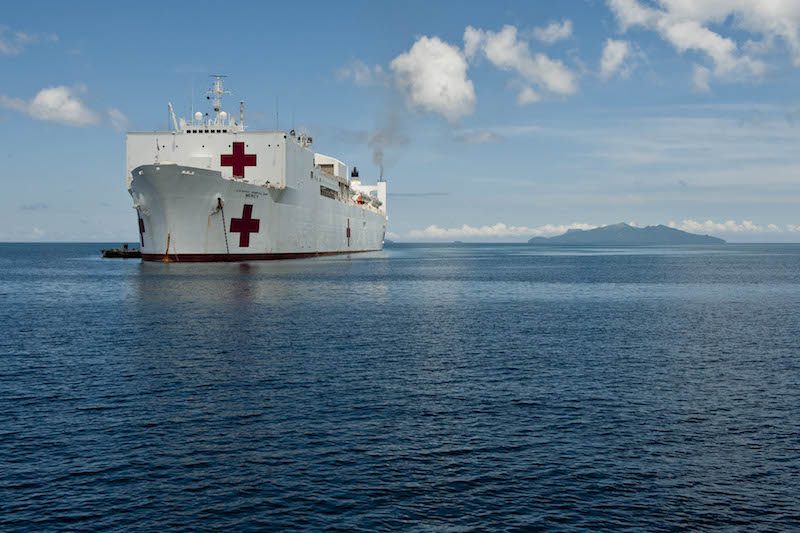The Military Sealift Command hospital ship USNS Mercy (T-AH 19) sits off the coast of the Philippines during Pacific Partnership 2012. U.S. Navy photo.
One of two hospital ships operated by the U.S. Navy’s Military Sealift Command has been put on standby and may be deployed to join in ongoing disaster relief efforts in the Philippines in the wake of Typhoon Haiyan.
The Navy said that on Wednesday, Adm. Harry B. Harris Jr., commander of the U.S. Pacific Fleet, directed the activation of the hospital ship, USNS Mercy (T-AH 19), which has been in a normal reduced operating status in San Diego. The activation order accelerates Mercy’s ability to attain full operating status and includes moving necessary personnel and equipment to the ship.
If ordered to deploy, Mercy would get underway in the next several days and could arrive in the Philippines sometime in December, joining other U.S. Pacific Fleet units already supporting Operation Damayan.
Earlier on November 11, Secretary of Defense Chuck Hagel ordered the aircraft carrier USS George Washington (CVN 73) and her escort ships to depart early from a liberty port in Hong Kong and head for the Philippines. George Washington, USS Antietam (CG 54), USS Cowpens (CG 63) and USNS Yukon (T-AO-202) were expected arrive off the coast of the Philippines sometime Wednesday evening.
After the central Philippines took a direct hit from Typhoon Haiyan last week, U.S. Pacific Fleet ships already operating in the Western Pacific were immediately diverted. These ships include USS Mustin (DDG 89), USS Lassen (DDG 82), USS Emory S. Land (AS 39), and USNS Bowditch (T-AGS 62) are now on location and coordinating with the Philippine government. The U.S. Navy also has P-3 maritime aircraft already supporting the disaster relief effort led by the Government of the Philippines.
Meanwhile, the amphibious ships USS Ashland (LSD 48) and USS Germantown (LSD 42) were expected to depart from Sasebo, Japan today. After picking up Marines, equipment and relief supplies in Okinawa, the two ships will arrive at the Philippines in approximately one week. USS McCampbell (DDG 85) and USNS Charles Drew (T-AKE 10) are also heading to the Philippines.
This collection of ships and their complement of aircraft, to include much-needed helicopters, will provide food and water, the capability to move relief supplies to isolated areas, and to help move the badly injured for medical care.
The U.S. Navy says it persistently trains with numerous Pacific nations and military units, including the Armed Forces of the Philippines, to prepare for humanitarian assistance and disaster relief missions. In 2012, Mercy participated in the annual Pacific Partnership mission, visiting Cambodia, Vietnam, Indonesia and the Philippines, where nearly 50,000 patients were treated and more than 900 surgeries were performed. In addition to human patients, veterinarians treated approximately 7,000 animals and engineers built or refurbished 13 school and health care buildings.
Operation Damayan is part of the broader U.S. Government effort to support the Government of the Philippines’s request for humanitarian assistance. This joint team effort includes coordination by the U.S. Department of State and U.S. Agency for International Development, in constant consultation with Philippine authorities. To date, Philippine and U.S. personnel have transported more than 107,000 pounds of relief supplies.
Converted from a commercial oil tanker, Mercy was delivered to the Navy in 1986. The ship is operated by civil service mariners from MSC and staffed by a combination of military and civilian medical personnel and non-governmental organizations during missions.

 Join The Club
Join The Club











